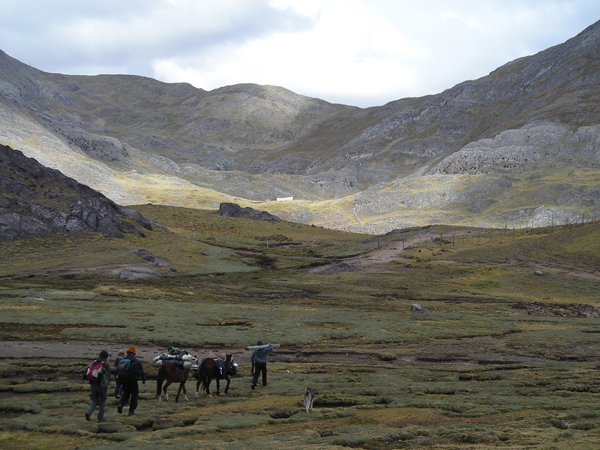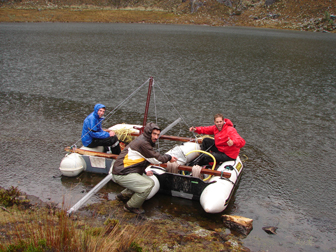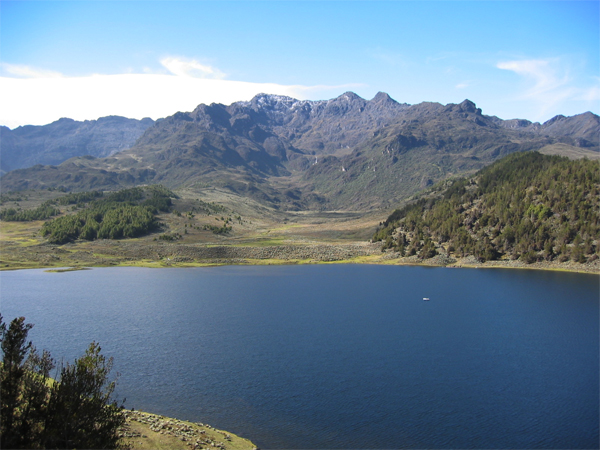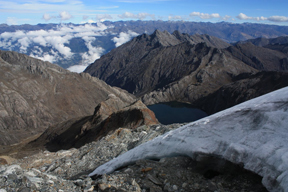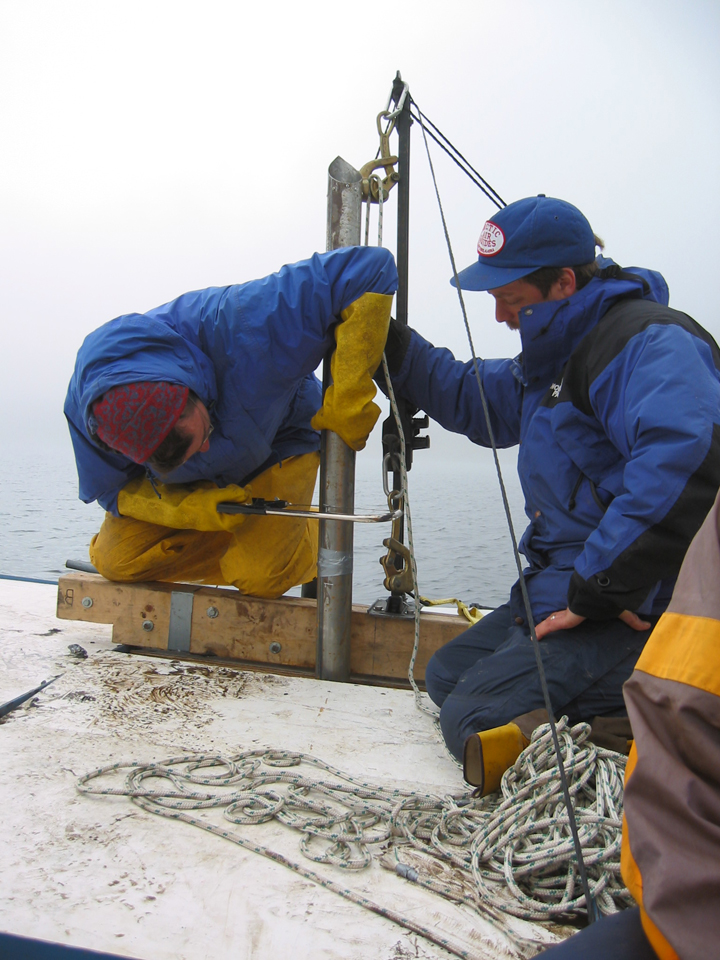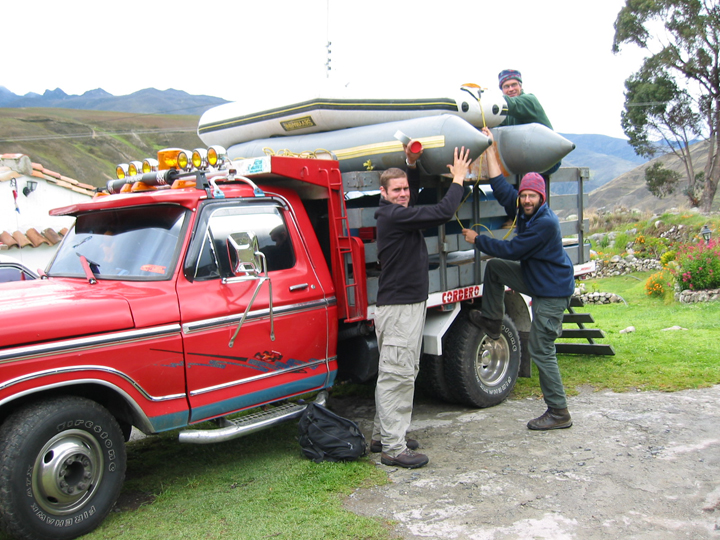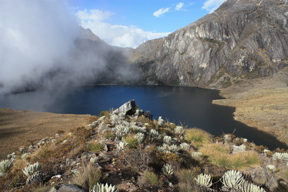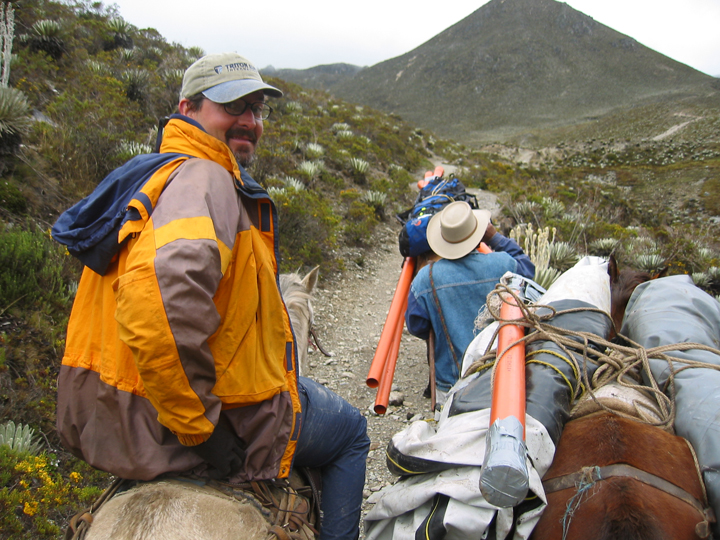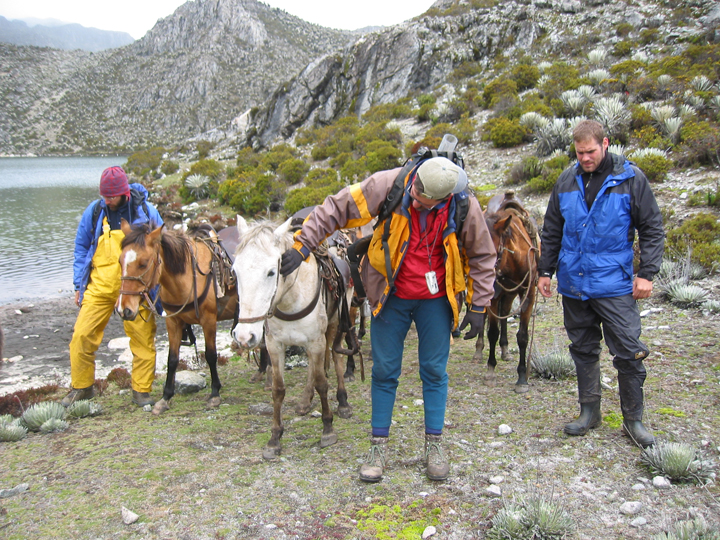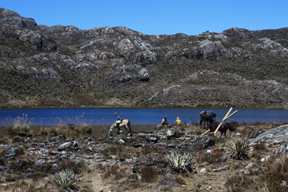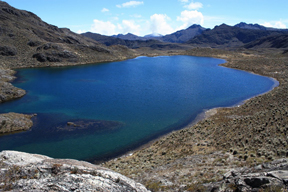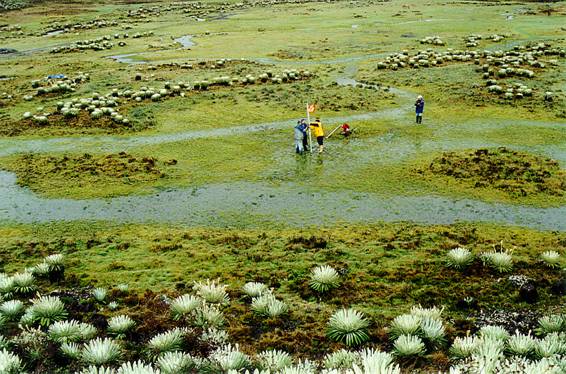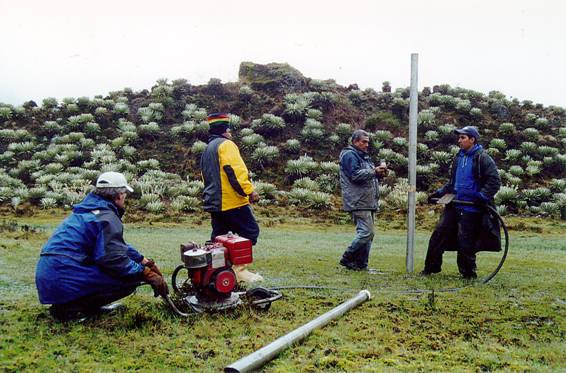 |
||||||||||||||
|
|
||||||||||||||
|
Venezuelan Andes
|
|
Lacustrine Records of Late Quaternary Water Balance Fluctuations in the Venezuelan Andes and the impact on Glaciation - Collaborators include Max Bezada, Nathan Stansell, Valenti Rull, Alex Wolfe, Pratigya Polissar, Carsten Braun, Darren Larsen, Mathias Vuille, Meagan Mazzarino, Encarni Montoya, Tania Ballesteros, Teresa Vegas Vilarrubia among others The objective of this project is to produce new multi-proxy high-resolution paleoclimate records from the Venezuelan Andes and to test hypotheses concerning the causes of shifts in the Precipitation-Evaporation (P-E) balance from ~18 ka B.P. to the present. Previous work provides only a broad paleoclimatic picture for this period: prolonged and intense aridity from the Last Glacial Maximum to the glacial-interglacial transition, and a complicated history of water balance shifts throughout the Holocene. The research has three key goals:(1) To produce well-dated records of several climatically-sensitive proxies at century-scale resolution, in order to identify regional patterns of P-E balance from ~18 ka to present; (2) To identify higher frequency hydrological fluctuations over the past 2000 years, using more detailed analyses of the same proxies at higher resolutions (multidecadal or better); (3) To compare these results with findings from our ongoing research on montane lake records in the Southern Hemisphere (Bolivian Andes). We are applying an integrated methodology that combines sedimentology, sediment magnetic characteristics, elemental and isotopic geochemistry, diatoms, and pollen. The primary proxies we useare calibrated in climatic terms through modern collections along altitudinal gradients. These records are needed to better understand the significance of shifts in the P-E balance and to address the following three hypotheses: (1) The P-E balance of the Venezuelan Andes is driven primarily by insolation changes at the millennial timescale during the Holocene, when boundary conditions were no longer significantly affected by changes in continental ice volume or sea level; (2) Millennial-scale changes in the seasonal distribution of insolation across the Tropics of the Northern and Southern Hemispheres drive changes in the location and strength of convection during the summer wet season. These effects are greater in regions that have a single wet season at the northern and southern limits of the annual migration of the Intertropical Convergence Zone (i.e. the Venezuelan and Bolivian Andes); (3) The P-E balance of the Venezuelan Andes has undergone decadal- to centennial-scale fluctuations during the Holocene, with periodicities that are too short to be driven by seasonal insolation variations. This research seeks to produce time-series for these climatic shifts that can be used to explore the mechanism responsible for such changes, such as oceanic variability. Resulting publications include Synchronous Interhemispheric Holocene Climate Trends in the Tropical Andes. Holocene variations of tropical moisture balance have been ascribed to orbitally forced changes in solar insolation. If this model is correct, millennial-scale climate evolution should be antiphased between the northern and southern hemispheres, producing humid intervals in one hemisphere matched to aridity in the other. Here we show that Holocene climate trends were largely synchronous and in the same direction in the northern and southern hemisphere outer-tropical Andes, providing little support for the dominant role of insolation forcing in these regions. Today, sea- surface temperatures in the equatorial Pacific Ocean modulate rainfall variability in the outer tropical Andes of both hemispheres, and we suggest that this mechanism was pervasive throughout the Holocene. Our findings imply that oceanic forcing plays a larger role in regional South American climate than previously suspected, and that Pacific sea-surface temperatures have the capacity to induce abrupt and sustained shifts in Andean climate. Proglacial Lake Sediment Records Reveal Holocene Cliamte Changes in the Venezuelan Andes. Lake sediment records from the Cordillera de Mérida in the northern Venezuelan Andes document the history of local glacial variability and climate changes during the Holocene (~12 ka to the present). The valleys that contain these lakes have similar bedrock compositions and hypsometries, but have different headwall elevations and aspects, which makes them useful for investigating the magnitude of past glaciations. There was widespread glacial retreat in the Venezuelan Andes during the early Holocene, after which most watersheds remained ice free, and thus far only valleys with headwalls higher than ~4400 m asl contain evidence of glaciation during the last ~10 ka. There was a pronounced shift in sediment composition for the Montos (headwall: ~4750 m asl) and Los Anteojos (headwall: ~4400 m asl) records during the middle Holocene from ~8.0 to 7.7 ka when conditions appear to have become ice free and drier. There is tentative evidence that the glacier in the Mucubají valley (headwall: ~4609 m asl) advanced from ~8.1 to 6.6 ka and then retreated during the latter stages of the middle Holocene. Clastic sediment accumulation in other nearby lake basins was either low or decreased throughout most of the middle Holocene as watersheds stabilized under warmer and/or drier conditions. In the Montos record, there was another major shift in sediment composition that occurred from ~6.5 to 5.7 ka, similar to other regional records that suggest conditions were drier during this period. Overall, the late Holocene was a period of warmer and wetter conditions with ice extent at a minimum in the northern tropical Andes. There were also punctuated decadal to multi-centennial periods of higher clastic sediment accumulation during the last w4 ka, likely in response to periods of cooling and/or local precipitation changes. In watersheds with headwalls above 4600 m asl, there is evidence of glacial advances during the Little Ice Age (~0.6-0.1 ka). The pattern of glacial variability is generally similar in both the northern and southern tropics during the Little Ice Age, suggesting that ice margins in both regions were responding to colder and wetter conditions during the latest Holocene. The observed pattern of Holocene climate variability in the Venezuelan Andes cannot be explained by insolation forcing alone, and tropical ocean influences were likely associated with the observed glacial and lake level changes. Solar Modulation of Little Ice Age Climate in the Tropical Andes. The underlying causes of late-Holocene climate variability in the tropics are incompletely understood. Here we report a 1,500-year reconstruction of climate history and glaciation in the Venezuelan Andes using lake sediments. Four glacial advances occurred be- tween anno Domini (A.D.) 1250 and 1810, coincident with solar- activity minima. Temperature declines of -3.2 +/- 1.4°C and precipitation increases of ~20% are required to produce the observed glacial responses. These results highlight the sensitivity of high- altitude tropical regions to relatively small changes in radiative forcing, implying even greater probable responses to future anthropogenic forcing.
Abrupt Younger Dryas Cooling in the Northern Tropics Recorded in Lake Sediments from the Venezuelan Andes. A radiocarbon dated sediment record from Laguna de Los Anteojos, a cirque lake in the Mérida Andes of Venezuela, indicates that warmer and wetter atmospheric conditions occurred in the northern tropics at the onset of the Bølling (~14,600 cal yr BP), and abruptly colder and drier conditions around the time of the Younger Dryas (YD). Geochemical and clastic sediment analyses from Los Anteojos show that glaciers advanced at ~12,850 cal yr BP, reached their YD maximum extent at ~12,650 cal yr BP, and then retreated until complete deglaciation of the watershed at ~11,750 cal yr BP. The onset of warmer conditions that ended the coldest phase of the YD occurred several hundred years earlier at Los Anteojos than in the high latitudes of the Northern Hemisphere. During the peak YD glacial advance, glacier equilibrium-line altitudes in the region were ~360 to 480 m lower, and temperature was ~2.2 to 2.9 °C colder than modern. Independent palynological evidence from the Los Anteojos sediment core indicates that the northern Andes were more arid and at least 2.3 °C colder during the YD. The direction and timing of glacial fluctuations in Venezuela are consistent with observations of marine sediment records from the Cariaco Basin that suggest abrupt cooling occurred at ~12,850 cal yr BP, followed by a shift to higher temperature after ~12,300 cal yr BP. The timing and pattern of climatic changes in northern South America are also consistent with paleoclimate records from the southern Tropical Andes that suggest a southward shift in the position of the Intertropical Convergence Zone occurred at the start of the cooling event, followed by a return to wetter conditions in northern South America during the late stages of the YD. The early warming of the tropical atmosphere and invigoration of the hydrologic cycle likely contributed to the shift to increased temperature in the higher latitudes of the Northern Hemisphere at the end of the late Glacial stage.
Last Glacial Maximum Equilibrium-Line Altitude and Paleo-Temperature Reconstructions for the Cordillera de Mérida, Venezuelan Andes. The pattern and magnitude of glacier equilibrium-line altitude (ELA) lowerings in the tropics during the last glacial maximum (LGM) are topics of current debate. In the northern tropics, paleo-ELA data are particularly limited, inhibiting the ability to make regional and large-scale paleoclimatic inferences. To improve these records, nine paleo-glaciers in the Venezuelan Andes were reconstructed based on field observations, aerial photographs, satellite imagery and high-resolution digital topographic data. Paleo-glacier equilibrium-line altitudes (ELAs) were estimated using the accumulation-area ratio (AAR) and the area-altitude balance ratio (AABR) methods. During the local LGM in Venezuela (~22,750 to 19,960 cal yr BP), ELAs were ~850 to 1420 m lower than present. Local LGM temperatures were are at least 8.8 ± 2°C cooler than today based on a combined energy and mass-balance equation to account for an ELA lowering. This is greater than estimates using an atmospheric lapse rate calculation, which yields a value of 6.4±1°C cooler. The paleo-glacial data from the Venezuelan Andes support other published records that indicate the northern tropics experienced a greater ELA lowering and possibly a greater cooling than the Southern Hemisphere tropics during the LGM.
Holocene Hydrologic Balance of Tropical South America from Oxygen Isotopes of Lake Sediment Opal, Venezuelan Andes. Precipitation in the South American Andes is derived from Atlantic Ocean evaporation which is modified by passage over lowland South America. The isotopic composition of Andean precipitation reflects evaporation conditions over the Atlantic Ocean, moisture recycling during advection across the South American lowlands and uplift to the Andes. Records of the oxygen isotope composition of precipitation in the Venezuelan Andes, derived from lake sediment diatom d18O measurements, show a 2.4‰ decrease during the past 10,000 yr. A simple model of the evaporation, advection and uplift processes is used to understand the cause of the isotope shift. The data and model suggest that the decreasing d18O reflects a decrease in the fraction of moisture entering South America that reaches the Andes. Ice cores from Peru and Bolivia exhibit similar isotope trends indicating that the shift occurred in both hemispheres. An isotopic record of Amazon River discharge is consistent with the Andean records, indicating increasing continental runoff was associated with the decreasing export of water vapor. Orbital changes in solar insolation cannot explain the synchronous trends in both hemispheres. Changing climate in the tropical Pacific is an attractive explanation for the trends because modern interannual variability in this region has similar effects in both hemispheres. |
|
